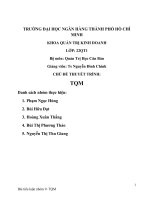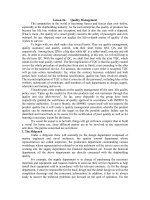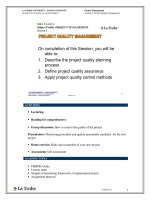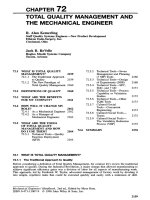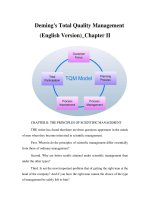Tài liệu Research " Total Quality Management: An Organizational Communication Analysis " docx
Bạn đang xem bản rút gọn của tài liệu. Xem và tải ngay bản đầy đủ của tài liệu tại đây (472.01 KB, 175 trang )
Copyright
by
Richard Jefferson Webb
2002
The Dissertation Committee for Richard Jefferson Webb
Certifies that this is the approved version of the following dissertation:
Total Quality Management:
An Organizational Communication Analysis
Committee:
__________________________
Larry D. Browning, Supervisor
__________________________
Craig R. Scott
__________________________
Dawna I. Ballard
__________________________
Patricia D. Witherspoon
__________________________
Sim B. Sitkin
Total Quality Management:
An Organizational Communication Analysis
by
Richard Jefferson Webb, B.A., M.A.
Dissertation
Presented to the Faculty of the Graduate School of
the University of Texas at Austin
in Partial Fulfillment
of the Requirements
for the Degree of
Doctor of Philosophy
The University of Texas at Austin
August 2002
UMI Number: 3108533
Copyright 2002 by
Webb, Richard Jefferson
All rights reserved.
________________________________________________________
UMI Microform 3108533
Copyright 2004 ProQuest Information and Learning Company.
All rights reserved. This microform edition is protected against
unauthorized copying under Title 17, United States Code.
____________________________________________________________
ProQuest Information and Learning Company
300 North Zeeb Road
PO Box 1346
Ann Arbor, MI 48106-1346
Dedicated to the memory of
Margaret R. Webb
William F. Webb
Richard V. Hart
Francis B. Hart
v
Acknowledgements
I am grateful for the encouragement and support of many dear friends and colleagues.
I would, however, especially like to acknowledge the following:
Professor Larry D. Browning, for his devotion to this project and to my success;
Selene Vega, who helped me find the strength to persist when my confidence was
shaken;
and
Christine M. Bailey, whose love, encouragement, and technical assistance made all
the difference.
vi
Total Quality Management:
An Organizational Communication Analysis
Publication No.
Richard Jefferson Webb, Ph.D.
The University of Texas at Austin, 2002
Supervisor: Larry D. Browning
During the 1980s and 1990s widespread concern about quality among U. S.
corporations provided the discursive foundation for a new technology of workplace
governance. The worklives of hundreds of thousands of U. S. employees were
directly affected by the institutionalization of total quality management (TQM)
programs. However, theoretical and empirical articles discussing communication
within TQM organizations are almost nonexistent. This dissertation employs content
analysis of qualitative data collected at ten TQM organizations to provide a grounded
theory of the role of communication in total quality management.
vii
TABLE OF CONTENTS
List of Tables ix
List of Figures x
CHAPTER 1: THE STUDY OF COMMUNICATION IN TOTAL
QUALITY MANAGEMENT 1
Statement of the Problem 1
Rationale 2
Total Quality Management: Principles, Practices, and Techniques 5
Defining Quality 6
Customer Satisfaction 8
Direct Customer Contact 8
Collecting Information About Customer Needs 9
Quality Function Deployment 10
Continuous Improvement 10
Benchmarking 11
Statistical Process Control 12
Teamwork 12
Diversity 13
Cohesiveness 15
Group Skills Training 16
Team-building 18
Summary 25
CHAPTER 2: METHOD 27
Historical and Conceptual Overview 27
Participant-Observation 29
Interviewing 31
Data 33
Analytical Framework 35
Unit of Analysis 35
Coding 36
Credibility 41
Summary 44
CHAPTER 3: FUNCTIONAL ANALYSIS 45
Communication Issues 45
Intraorganizational Communication Issues 46
Interorganizational Communication Issues 49
Communication and Integrative Problem Solving 51
Intraorganizational Team Diversity 52
Cross-functional Team Membership 52
Superior-Subordinate Collaboration 56
viii
Direct Contact Between Customers and Suppliers 61
Theoretical Implications 71
Summary 76
CHAPTER 4: ROMANTIC ANALYSIS 78
Empowerment 79
Cohesiveness 84
Incentives and Rewards 89
Theoretical Implications 93
Summary 97
CHAPTER 5: CRITICAL ANALYSIS 98
Bureaucratic Control 98
Concertive Control 101
Resistance/Opposition 109
Theoretical Implications 114
Summary 119
CHAPTER 6: CONCLUSION 121
Summary of Findings 121
Suggestions for Future Research 132
ENDNOTES 135
REFERENCES 138
VITA 164
ix
List of Tables
Table 2.1: Pseudonyms of Participating Organizations 34
Table 2.2: Secondary Coding Matrix. 40
x
List of Figures
Figure 3.1 Causal MapFunctional72
Figure 4.1 Causal MapRomantic.94
Figure 5.1 Causal MapCritical 116
Figure 6.1: Causal MapCollective.128
1
CHAPTER 1: THE STUDY OF COMMUNICATION
IN TOTAL QUALITY MANAGEMENT
This chapter provides an introduction to the dissertation, and is divided into
three sections. The first section provides a statement of the problem under
investigation. The second section provides a rationale for the study, addressing the
questions of why the problem is worth investigating, and how the dissertation
contributes to organizational communication theory. The third section provides
definitions and conceptual parameters for the area under investigation, and presents
the research questions that guided the analysis of data. The chapter concludes with a
brief summary.
Statement of the Problem
During the 1980s and 1990s, widespread concern about quality among U.S.
organizations, as a result of Japanese competition, provided the discursive foundation
for a new technology of workplace governance. The worklives of hundreds of
thousands of U.S. employees and the economic futures of thousands of organizations
were directly affectedfor better or worseby the institutionalization of total quality
management (TQM) programs. Yet, by the close of the 20th century, quality
initiatives were finding less and less support in U.S. manufacturing and service
organizations. Choi and Behling (1997, p. 37) summarize several surveys that
indicate executive dissatisfaction with TQM and that document a significant drop in
its use, including
2
an American Electronics Association survey [which] revealed that use of
TQM by member firms dropped from 86 percent in 1988 to 73 percent in
1991 and that 63 percent of the firms reported that TQM failed to reduce
defects by 10 percent or more, even though they had been in operation for
almost two and one-half years on average; McKinsey & Company found that
two-thirds of the TQM programs it examined had simply ground to a halt
because they failed to produce expected results.
A number of researchers have wondered why TQM has proven to be less
effective than promised and has encountered such a precipitous decline in popularity.
Most have focused upon implementation difficulties, including lack of managerial
support (Choi & Behling, 1997; Hill, 1995; Wilkinson & Willmott, 1995), ineffective
positioning of change initiatives relative to organizational contingencies (Sitkin,
Sutcliffe, & Shroeder, 1994), poor deployment of statistical process controls
(Hackman & Wageman, 1995; Zbaracki, 1998), and partialversus complete
implementation strategies (Douglas & Judge, 2001). There has been little agreement,
and no consensus, concerning the nature of the problem and whether anything can
or shouldbe done about it.
Rationale
One area that has received little attention is the role of communication in
TQM programs, although the use of group communication processes and team-based
problem-solving are fundamental TQM practices. Despite the considerable body of
literature on group and team communication, there has been almost no attention given
3
to an examination of the successes and failures of TQM from the vantage point
offered by communication theory. While some effort has been devoted to articulating
management theories implicit in TQM practice (Anderson, Rungtusanatham, &
Schroeder, 1994; Dean & Bowen, 1994; Sitkin et al., 1994; Spencer, 1994; Waldman,
1994), the role of communication in organizational quality initiatives has largely
slipped by the wayside (Allen & Brady, 1997). Since an understanding of
communication would seem to be fundamental to the theoretical and practical
development of organizational quality initiatives, and since quality must be
considered among the worthiest of organizationaland theoreticalconcerns, this
dissertation is predicated upon the need for a close examination of the role of
communication in Total Quality Management.
Communication is central to the articulation of problems, to the constitution of
programs of action, and to the judgments made about problem analysis and responses
(Hirokawa & Rost, 1992). Yet, with very few exceptions (Allen & Brady, 1997;
Browning, Sitkin, Sutcliffe, Shetler, & Obstfeld, 2000; Fairhurst,1993; Fairhurst &
Wendt, 1993; Sutcliffe, Sitkin, & Browning, 1999; Wendt,1994) organizational
communication theorists have been conspicuously absent from the scholarly
discussion of TQM. As Allen and Brady have put it, authors of practitioner-oriented
TQM books readily acknowledge communications importance . . . [yet] few other
management concepts or practices have received so much practitioner attention with
so little academic study (1997, pp. 316-317). Not that this has prevented numerous
communication-based concepts from appearing in that discussion. For instance,
4
Munro (1995) refers to both a discourse and a rhetoric of quality; Webb (1995)
ties rhetoric and persuasion to her claim that "TQM translat[es] enterprise ideology
into material practices" (p. 106); Tuckman (1995) also refers to the rhetoric of TQM,
and contends that the "growing and pervasive concern over quality [is an effect of]
the emergent ideology, practice, andimportantly discourse of TQM" (p. 54).
Kerfoot and Knights (1995) claim to examine the discourse or rhetoric of quality in
terms of the conditions that render it plausible to practitioners, and the effects that it
has as a practice on organizations and their employees" (p. 220). Zbaracki (1998)
attempts to contrast rhetorical TQM with technical TQM, attacking the first as an
obstruction to the second. Westphal, Gulati, and Shortell (1997) discuss the role of
"communication ties" (p. 372) in the institutional forces that encourage conformity in
TQM adoption. Yet rarely if ever are such analyses informed or supported by the
relevant literature from the field of Communication Studies. According to Allen and
Brady, theoretical and empirical articles discussing communication within TQM
organizations are almost nonexistent (1997, p. 322). In particular, virtually no
attention has been paid to the role of communication in the team-based, problem-
solving contexts that are both fundamental to TQM in theory and as actually practiced
by virtually all TQM organizations. This dissertation provides a valuable
communication-based critique and extension of the current theory and practice of
TQM. More specifically, I believe that the study of communication can provide
crucial insights into the successes and failures of teamwork in quality initiatives, and
that an empirical examination of the role of communication in quality teams will
5
provide a basis for the development of theories of communication in organizational
contexts.
To provide a backdrop for this analysis, the next section turns to a
consideration of the basic principles of TQM, the practices and supporting techniques
through which quality initiatives are defined and implemented, and a review of the
literature as it relates to the processes operating in quality-focused organizational
teams. As a preface to this discussion, I turn first to an analysis of the term quality
itself as the basis for discussing organizational change initiatives.
Total Quality Management: Principles, Practices, and Techniques
Despite a documented decline in the number of organizations claiming to use
TQM, concern about product and service quality is still pervasive. Many
organizations employ some or all of the principles, practices, and techniques of TQM
under some different label; and, as a recent survey of companies using specific
management tools revealed, literally thousands of companiesover 40 percent of
those surveyed reported that they currently use TQM (Fashion victims, 2000).
Quality as a concept, however, is far from stable, and its meaning is highly
contestable. As Munro (1995) explains, "a key matter to be grasped in the quality
debate is that quality is problematizing . . . The new techniques which form
themselves under the rubric of 'quality' are multiple, heterogeneous, and uncertain . . .
Quality's elusiveness to definition appears to be part of its resource" (p. 130).
Considerable professional effort has been devoted to stabilizing both the concept of
quality and the content of TQM programs. This section turns first to a summarization
6
of four widely used definitions of quality, then identifies three central principles
shared by most conceptions of TQM initiatives: customer satisfaction, continuous
improvement, and teamwork.
Defining Quality
Reeves and Bednar (1994) discuss four prevailing definitions of qualityas
excellence, as value, as conformance to specifications, and as meeting or exceeding
customers expectationsno one of which applies equally well to all products or all
services in all industries. They explain that each quality definition has strengths and
weaknesses in relation to measurement and generalizability, managerial usefulness,
and consumer relevance (Reeves & Bednar, p. 435). A brief consideration of each of
these definitions is in order.
Quality defined as excellence has its roots in the ancient Greek concept of
aretê, i.e., excellence or virtue, which varies according to context: the properties of an
excellent automobile are not the same as the properties of an excellent meal, or of an
excellent person. Although Crosby (1979, p. 14) argues that the first erroneous
assumption is that quality means goodness, or luxury, or shininess, or weight, this
definition may be the easiest for organizational management to articulate, and it may
provide the most substantive basis for employee motivation and commitment (Reeves
& Bednar, 1994). On the other hand, the notion of excellence is problematically
abstract, subjective, and variable over time, making a definition of quality as
excellence of limited value to managers and researchers who desire a more reliable,
measurable standard.
7
Quality defined as value is the least supportable definition. It appears to be
based upon a constellation of attributes, including convenience, availability, and
price, as well as excellence. According to Reeves and Bednar (1994), quality theorists
Feigenbaum and Abbot both asserted that differentiation in levels of both quality and
price, or value, were important in consumers decisions (p. 421). The statement
appears to distinguish quality from price, combining these disparate measures into the
construct, value. How or why this then becomes synonymous with quality is far from
clear. Value is seen by some to be a subcomponent of quality, whereas others view
quality as a subcomponent of value . . . Quality may be a component of value, but
value is not synonymous with quality (Reeves & Bednar, p. 430).
The most parsimonious and easily verified definition of quality is
conformance to specifications (Reeves & Bednar, 1994; Tuckman, 1995). It is based
essentially on the need for the kind of consistency and quantifiability that
accompanied mass production techniques. On the other hand, consistent conformance
to specifications does little to facilitate organizational adaptation, to predict changing
customer requirements, or to encourage innovation and worker discretion (Hackman
& Wageman, 1995; Reeves & Bednar, 1994; Sitkin et al., 1994).
The fourth definition of quality, and the one most widely accepted by TQM
theorists and practitioners (Anderson et al., 1994; Dean & Bowen, 1994; Feigenbaum,
1991; Reeves & Bednar, 1994; Tuckman, 1995), is meeting or exceeding customers
expectations. Its centrality to the design and implementation of TQM programs is best
reflected by the fact that customer satisfaction, together with continuous improvement
8
and teamwork, is widely considered one of TQMs fundamental principles (Dean &
Bowen, 1994; Hill, 1995; Sitkin et al., 1994; Westphal et al., 1997). It is to a
consideration of these principles, and their underlying practices and techniques, that
this discussion now turns.
Customer Satisfaction
As indicated above, the relevance of customer satisfaction in any theory of
quality management is apparent because the very definition and, consequently, the
measurement of customer satisfaction often has been based on a customers
perception of the quality of products and services (Anderson et al., 1994, p. 491). In
concert with the principles of continuous improvement and teamwork, customer
satisfaction provides both the impetus for instituting and the standard for evaluating
total quality initiatives.
Three practices are identified by Dean and Bowen (1994) as instrumental in
providing customer satisfaction: direct contact between product and/or service
providers and their customers; the collection of specific information about customer
requirements; and the inclusion of information provided by customers in the design
and delivery of products and/or services.
Direct Customer Contact
In the lexicon of TQM, customers may be thought of as both the final
consumers of an organizations products or services, or as organizational members
who themselves depend upon the outputs of other organizational insiders. For
example, automobile painters may be thought of as internal customers whose work
9
depends upon the output of automotive sheet metal fabricators.
1
At the conclusion of
this internal supplier-customer chain of relationships, the finished automobile is
ultimately offered for sale by dealers to whom a number of external customers turn
for the satisfaction of their personal transportation needs. As Waldman (1994) has
explained, TQM involves giving employees direct communication and responsibility
for managing relationships with clients, presumably including those either internal or
external to the organization (p. 522). Direct contact between employees and
customers, either internal or external, is the method by which essential information is
collected.
Collecting Information About Customer Needs
Fundamental to the issue of providing customer satisfaction is the idea of
gathering information from customers about their specific requirements. Although
systematic data are not available on the proportion of TQM organizations that directly
assess customer preferences and customer satisfaction, nearly all case studies of TQM
companies include descriptions of the means such organizations use to obtain
customer data (Hackman & Wageman, 1995, p. 316). Reger, Gustafson, Demarie,
and Mullane (1994) argue that direct contact between product or service providers
and their customers is likely to make members aware of the shortcomings of the
existing organization, and customers communication about their ideals for the
organization may prompt members to reassess their views (p. 575). Customer
surveys and focus group discussions are used by organizations to gather necessary
10
information, and improvements in product or service quality are consequently based
upon the information provided by customers themselves.
Quality Function Deployment
The last of the practices associated with providing customer satisfaction is the
actual translation of customer-supplied information into the design and delivery of an
organizations products or services. Dean and Bowen (1994) refer to this as quality
function deployment (p. 394), or by the Japanese term hoshin kanri (p. 404; see
also Waldman, 1994). The function of communication in the construction and
enactment of relationships between customers and product or service providers
constitutes one of the focal points for data analysis in this dissertation, as expressed in
the following research question:
RQ 1: Among organizations using TQM, what is the function of
communication in satisfying customer requirements?
Continuous Improvement
The second fundamental principle associated with TQM is continuous
improvement. Continuous improvement is generally presented as the key to customer
satisfaction
2
(Deming, 1986; Johnston & Daniel, 1991), and is generally understood
to comprise both technical processes and human resource considerations. The
analysis of work processes is the starting point for organizations oriented toward
continuous improvement. Process analysis has as its primary objective the reduction
or elimination of variance, which Deming (1986) saw as the source of problems in
providing quality products and services. A reduction in process variation leads to
11
benefits such as increasing output uniformity, continual reduction of rework and
mistakes, continual reduction of waste of staffing, machine time, and materials
(Anderson et al., 1994, p. 494; see also Anderson, Dooley, & Misterek, 1992;
Belohlav, 1993; Crosby, 1979, 1989; Phillips, Chang, & Buzzell, 1983). Two
techniques that are generally associated with continuous improvement are the use of
benchmarking and the use of statistical process controls.
Benchmarking
Benchmarking involves the identification of best practices from among
competitors in a given industry, or from among the recognized leaders in any of a
variety of industries, for the purpose of improving organizational processes and
enhancing competitive position (Camp, 1989; Hackman & Wageman, 1995; Olian &
Rynes, 1991). The examples thus provided by highly successful organizations may
encourage the elevation of process improvement objectives and the willingness of
members to accept quality-focused organizational changes (Reger et al., 1994). On
the other hand, Hackman and Wageman assert that the popularity of benchmarking
among TQM organizations may result primarily from its inclusion as a Baldridge
Quality Award criterion, and that the benefits of benchmarking cannot be assumed to
accrue without exception. They note that standardization and insistence upon process
improvements identified as the best in a particular field reduce or eliminate worker
discretion in the performance of tasks, and may, as a result, interfere with their
adoption (Ulrich, Von Glinow, & Jick, 1993) and negatively affect employee
motivation (Hackman & Oldham, 1980).
12
Statistical Process Control
Statistical process control comprises a range of tools, the use of which is
generally argued to be essential to the effective implementation of TQM initiatives
(Dondero, 1991; Oakland & Followell, 1990; Rucinski, 1991; Sashkin & Kiser,
1993)
3
. Anderson et al. (1994) argue that there is ample anecdotal evidence, for
instance, to support a relationship between statistical process control and quality
improvements (p. 495). The list of tools associated with statistical process control is
extensive (Choi & Behling, 1997): flowcharts and control charts, fishbone diagrams,
Pareto charts, and cost-of-quality analysis are among the most widely employed
techniques (Hackman & Wageman, 1995). Together, they constitute an orderly
system for identifying and quantifying those actions and processes that contribute
toor detract fromefforts at achieving acceptable quality in products and services.
Teamwork
The third fundamental principle generally associated with TQM is teamwork.
As continuous improvement is seen as the basis for providing customer satisfaction,
the use of teams is seen as necessary to continuous improvement (Dean & Bowen,
1994). The TQM literature consistently identifies teams as the context and teamwork
as the necessary requirement for effective problem analysis and decision making with
respect to continuous improvement and customer satisfaction (Dean & Bowen, 1994;
Hackman & Wageman, 1995). According to March (1994), however, the existence of
inconsistencies in the interests and identities of team members is at variance with the
most accurate meaning of the word. March prefers to describe real multiple actor
13
decision making bodies as groups, but allows for the use of the term teams as an
approximation or simplification. It is in this sense, in order to remain consistent with
the language used in the TQM literature, that the terms groups and teams will be used
interchangeably in this dissertation. In both cases, I am referring to multiple actors
who communicate with and influence each other in pursuing some common objective.
Hackman and Wageman (1995) contend that the single most commonly used
TQM technique is formation of short-term problem-solving teams with the overall
objective of simplifying and streamlining work practices (p. 315). Much of the
literature on team effectiveness focuses upon the general issues of diversity,
cohesiveness, and group communication processes. It is to a consideration of these
issues that this section now turns.
Diversity
Diversity is generally considered one of the sources of the fundamental
advantage that teams offer when compared to individual efforts (Kirchmeyer &
Cohen, 1992; McLeod, Lobel, & Cox, 1996; Rogelberg & Rumery, 1996). Although
the importance of managerial involvement is a cornerstone of TQM philosophy, one
of the primary sources of TQM team diversity comes from the inclusion of front-line
employees on problem-solving and decision-making teams. Several researchers
(Hackman & Wageman, 1995; Lawler, 1994) have argued that meetings between
managers and workers are a crucial source of ideas about how to improve operations
that directly impact the quality of outputs. Spencer (1994) notes that, in such teams,
both horizontal and vertical communication networks are established. Information
14
and advice, rather than instructions and decisions, are shared across functional areas
and between people of different rank (p. 457).
As important as hierarchically diverse teams may be, a number of researchers
have emphasized the significance of cross-functional team membership, i.e., teams
composed of employees from across a variety of task or departmental divisions.
Spencer (1994) explains that TQM embraces the use of cross-functional teams; users
recognize the value of constructive contention and the potential for recognizing new
opportunities when multiple perspectives clash (p. 453). The importance of diversity
is directly related to the variety of perspectives that are included when teams are
composed of members from across the organization. As Hackman and Wageman
(1995, p. 331) put it:
The cross-functional quality teams that are among the hallmarks of TQM
organizations stack the cards in favor of learning by the simple fact that they
are cross-functional; individual members are exposed to more, and more
diverse, points of view than would be the case if they worked mostly by
themselves or in within-function units. Moreover, the group-process heuristics
that teams are taught increase the chances that this built-in talent will be used
well.
A third consideration in terms of diversity is the formation of teams that
include customers as well as product or service suppliers. Customers in this context
may include internal customers, although this idea clearly coincides with the idea of
cross-functional team membership, as discussed above. More importantly, the

